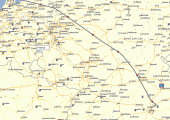
Munich – Amsterdam Schiphol
Private homepage – Hans-Georg Michna
Kenya travel reports: 1999, 2000, 2002, 2003, 2004, 2005, 2006, 2007, 2008, 2009, 2010, 2011, 2012, 2013-Goma, 2013, 2014, 2015, 2016, 2017, 2018, 2019
Kenya Safari Travel Plan, Flying from high-altitude airfields, Kenya 1980-2000 photos
Jörg's travel report (German) and photos, Mausi's photos
Kenya 2010
A personal travel report from Kenya in April and May 2010
Last change: 2010-06-21 – Copyright © 2010-2023 Hans-Georg Michna
Click on the small pictures to see them enlarged, usually to 800 x 600 pixels.
Times are given in local Kenyan time in 24 h format (without "am" or "pm"), i.e. 0:00 to 23:59 o'clock.
A few readers had the problem that after clicking on a picture, then going back to the main page, all thumbnail pictures were reloaded. This is typically caused by Internet Explorer cache corruption. It can often be repaired by going to the Internet options and deleting the temporary Internet files.
All photos are subject to copyright ©. If you want to reuse any photo, send me an email asking for permission, and I may send you the full-size photo, usually 1,600 x 1,200 pixels. Photos bear the copyright © 2010-2023 Hans-Georg Michnaor the copyright © 2010-2011 of the photographer mentioned under the photo.
EXIF times in the pictures are UTC; add 3 hours to get Kenya time.
[Still the same camera—my Panasonic Lumix DMC-FZ1-2 digital camera. Most photographs in this travel report are reduced to 800 x 600 pixels and JPEG-compressed with medium strength to make them more palatable for the web.]
| Departure | Arrival | Flight | Status |
|---|---|---|---|
| 07:10 Sun 25 April, Munich | 08:45 Sun 25 April, Amsterdam | KL 1790 | Flown |
| 10:25 Sun 25 April, Amsterdam | 19:25 Sun 25 April, Nairobi | KL 0565 | Flown |
| 08:40 Sun 30 May, Nairobi | 16:30 Sun 30 May, Amsterdam | KL 4140 | Flown |
| 17:50 Sun 30 May, Amsterdam | 19:15 Sun 30 May, Munich | KL 1799 | Flown |
My travelling checklist in michna.com/kenya.htm#Preparations (German version michna.com/kenia.htm#Reisevorbereitungen) is, as always, my means of packing without fear of forgetting anything important. As usual, the packing and other preparations take a full day of concentrated work, because they cover an immense number of small things and details. Without the checklist I'd be lost.
KLM and Kenya Airways on their flights to Nairobi currently allow two pieces of baggage of up to 23 kg each in the economy class. KLM also has a pretty good and informative web site, allowing ticket purchase, online check-in, and often seat selection.
My experience on such international flights, particularly from Nairobi, is that a lot of stress can be taken out of the check-in procedure by being at the airport just 10 to 15 minutes earlier than needed. In Munich the rush seems to begin 90 minutes before departure, in Nairobi at least two hours. Be there before that rush and everything is a lot more relaxed.
In the following text I report several details related to the planning of the group safari, which begins on May 10. If you are not interested in these details, you can skip all Nairobi days. I may later shorten these parts of the report.
My alarm clock rang at 4:15, and around 4:50 I was on the road to the airport.
The outside air temperature was 5°C, which I would later keep telling everybody who complained about the coolness of Nairobi during the rainy season.
The check-in was quick and uneventful, as expected. I had maxed out my luggage with 2 pieces of 23 kg each plus a bit more carry-on than permitted, assuming my second little shoulder bag would have been counted.
The first part of the flight from Munich to Amsterdam Schiphol was uneventful and timely.
I sat at the window, according to the general preferences I had once entered on KLM's web site, and could record the whole flight.
After a short wait in Amsterdam I could board the plane for the long flight to Nairobi. The plane was an airbus, not a Jumbo, with 2 + 4 + 2 seating. I sat in seat 41J, at the window on the right side, and next to me sat an archaeologist, a lady from Texas. As you can imagine, we talked a lot, because archaeology is one of my particular interests.
This was actually the reason why the first part of my flight was not recorded by the GPS, but later track recordings were also spotty because of an unfavorable satellite constellation (not enough satellites on my side of the plane).

Amsterdam – Nairobi (Munich – Amsterdam still visible in light grey)
The flight was on a real KLM plane, and it had a good entertainment system, where you can choose from a fair number of movies and can stop and continue your movie at any time. While my seat neighbor slept, I watched The Men Who Stare at Goats, but didn't find it particularly good as a movie. The ostensibly true story is astonishing, however.
The plane arrived on time, but this time I was about the last person to exit and consequently nearly the last person in the line at the visa counter, even though I applied the trick to go to the other counter room through a corridor on the left side. I guess too many people already know about that other counter room or the airport employees had already sent many people there. The only good thing is that the visa counter doubles as immigration counter, so I didn't have to line up a second time.
The temperature was warm inside the building, but even outside it was still 23°C, actually quite comfortable if you don't have to lift and carry heavy luggage.
I called Sajid Rasul, and he told me that he had my car ready at his home, which is on the airport side of Nairobi outside the city, so I later had to pay only KSh 1,300 for the taxi.
I got a three-month visa for $25. One could also pay €20 instead, but $25 was actually a tad cheaper.
When I went down the stairs into the baggage hall, I could already see both my big pieces of luggage on the conveyor belt, so everything was fine.
The customs form is unclear about what you should list in the table of imported goods. It looks a bit as if you should also declare currencies there, but a question before asks only for values exceeding $5,000. I didn't have that much and didn't declare anything. The form was accepted by the customs officer.
The customs officer asked the usual couple of questions, like where do you go (I travel as a tourist), what is in your luggage (only my personal belongings), etc., then he abruptly waved me through without looking into my luggage at all.
My guests will have it easier, because they can leave as a tour group, which is rarely checked. Note that it is advantageous to stick together as an obvious tourist group when going through customs. They rarely check tourists, because tourists rarely have anything of relevance to customs in their luggage and because tourists receive a somewhat preferred treatment.
After leaving the customs area, I turned left and took the few steps to the Barclays ATM on the wall to pull the maximum of KSh 40,000 from it. Since the machine offers only amounts up to 20,000 in its menu, the method is to select the universal account, cash withdrawal, type in the max. amout of 40,000, quickly remove and stow the card, then take the bundle of bank notes (thicker than 1 cm) and stuff it into your pocket without counting it. You don't want to stand in any open place in a developing country, counting a thick bundle of bank notes.
I forgot to pick up my receipt, and the lady at the nearby information counter pointed me back to it. She then offered me a taxi, and I accepted, although I normally prefer to pick the taxi and the driver myself. But this turned out to have been a good choice. The driver was a young man who spoke excellent English and was knowledgeable and humorous. We had a nice chat.
I arrived at Rasuls' home, was let in through the high metal gate, and already saw my car that was standing in the drive-in, one of the two Suzuki Maruti Gypsy four-wheel-drive cars we are going to use. We did the paperwork, and I gave Sajid Rasul a small MP3 player as a little gift.
Then I was invited to their Sunday barbeque and could not refuse. Sajid's wife brought me some typical Indian salad plate, followed by some nice barbeque meat. I enjoyed that and chatted with them for a while, but then I had to leave, because it was already late, and I feared that the Aero Club might already be closed.
Getting used to driving on the left side of the road didn't take long. Initially I kept thinking of it, but soon I was driving on the main Mombasa highway as if I had never driven on the right side before.
Along the way I had some light, drizzling rain shower, enough to use the windshield wipers a few times. Later in the night I should hear some more rain.
I arrived at the Aero Club of East Africa and was already expected by the night crew. I moved into my little room, took a shower, and slept very well under the flawless moquito net.
Today, Monday, was a very busy day with all kinds of preparations that are too many to list here. The weather was excellent, almost unusually warm for this time of the year, with lots of blue sky, sunshine, and a few short rain showers in the late afternoon.
I met Harvey, one of the elephant research project leaders, who had just flown his aeroplane in for maintenance and was going to fly to Amboseli tomorrow for two nights out in the bush. I gladly accepted his invitation to come with him, which will save me the extra drives to and from Amboseli. The plan was that we would be back on Thursday, and I had a checkout flight planned for Friday.
I enjoy the Kenyan tea on the Aero Club's terrace and am sitting here with my computer, writing this and chatting with a young woman from the Netherlands, who works for Ärzte ohne Grenzen (Médecins sans Frontières Deutschland), just arrived from Juba, southern Sudan, and spends the day here in the Aero Club waiting for her flight back home.
She had tales of temperatures up to 45°C in the Sudan and put on a warm jacket while I was still feeling warm in my shirt.
The Internet connection is poor. My first diagnosis indicated 55% packet loss, which means that it is really unworkable. Here's a little taste for the insiders:
tracert india155.server4you.de Traceroute to india155.server4you.de [85.25.149.191] 1 2 ms 1 ms 2 ms 192.168.100.1 2 27 ms 11 ms 10 ms 10.34.0.1 3 30 ms 26 ms 24 ms ge-1-0-0-bp_core01.accesskenya.com [196.207.31.33] 4 18 ms 17 ms 16 ms TenGE-2-1-BP_EDGE01.accesskenya.com [196.207.31.145] 5 99 ms 81 ms 82 ms if-4-1-0.core1.MLV-Mumbai.as6453.net [209.58.105.137] 6 165 ms 106 ms 107 ms if-4-0-1.core2.CFO-Chennai.as6453.net [116.0.84.9] 7 * * 320 ms if-0-0-0-1917.mcore5.LAA-LosAngeles.as6453.net [209.58.33.117] 8 317 ms * * Vlan1117.icore1.LAA-LosAngeles.as6453.net [209.58.33.2] 9 305 ms 323 ms 312 ms 4.68.63.65 10 321 ms 317 ms 324 ms ae-73-70.ebr3.LosAngeles1.Level3.net [4.69.144.116] 11 422 ms 401 ms 394 ms ae-4-4.ebr4.Washington1.Level3.net [4.69.132.82] 12 401 ms * 394 ms ae-74-74.csw2.Washington1.Level3.net [4.69.134.182] 13 * 406 ms 409 ms ae-72-72.ebr2.Washington1.Level3.net [4.69.134.149] 14 * 726 ms * ae-43-43.ebr2.Frankfurt1.Level3.net [4.69.137.57] 15 * * 728 ms ae-82-82.csw3.Frankfurt1.Level3.net [4.69.140.26] 16 * 720 ms 728 ms ae-3-89.edge5.Frankfurt1.Level3.net [4.68.23.141] 17 * * * Time limit exceeded. 18 * * * Time limit exceeded. 19 * 735 ms 728 ms static-ip-85-25-225-138.inaddr.intergenia.de [85.25.225.138] 20 * 736 ms * india155.server4you.de [85.25.149.191]
Some time later:
tracert india155.server4you.de Traceroute to india155.server4you.de [85.25.149.191] 1 4 ms 1 ms 1 ms 192.168.100.1 2 12 ms 16 ms 9 ms 10.34.0.1 3 9 ms 17 ms 25 ms ge-1-0-0-bp_core01.accesskenya.com [196.207.31.33] 4 13 ms 8 ms 14 ms TenGE-2-1-BP_EDGE01.accesskenya.com [196.207.31.145] 5 73 ms 74 ms 74 ms if-4-1-0.core1.MLV-Mumbai.as6453.net [209.58.105.137] 6 126 ms 127 ms 161 ms if-13-0-0.core2.MLV-Mumbai.as6453.net [209.58.105.42] 7 222 ms 236 ms 221 ms if-14-0-0-1729.core1.TV2-Tokyo.as6453.net [216.6.13.98] 8 408 ms 409 ms 462 ms if-12-0-0.mcore4.PDI-PaloAlto.as6453.net [216.6.86.25] 9 482 ms 479 ms 480 ms if-1-0-0-893.mcore4.NJY-Newark.as6453.net [216.6.63.17] 10 * * 567 ms if-1-0.mcore3.L78-London.as6453.net [195.219.144.9] 11 645 ms 757 ms 808 ms if-1-0-0-1656.mse1.LRT-London.as6453.net [195.219.144.34] 12 480 ms 481 ms 569 ms if-13-0-0-3.mcore3.LDN-London.as6453.net [195.219.195.21] 13 566 ms 571 ms * Vlan62.icore1.LDN-London.as6453.net [195.219.83.1] 14 569 ms 576 ms 568 ms xe-10-2-0-edge3.london1.level3.net [4.68.63.105] 15 * 643 ms 773 ms ae-34-52.ebr2.London1.Level3.net [4.69.139.97] 16 490 ms 478 ms 479 ms ae-48-48.ebr2.Amsterdam1.Level3.net [4.69.143.81] 17 474 ms 477 ms 475 ms ae-1-100.ebr1.Amsterdam1.Level3.net [4.69.141.169] 18 728 ms 728 ms 730 ms ae-48-48.ebr2.Dusseldorf1.Level3.net [4.69.143.210] 19 653 ms 649 ms * ae-1-100.ebr1.Dusseldorf1.Level3.net [4.69.141.149] 20 562 ms 580 ms 587 ms ae-47-47.ebr2.Frankfurt1.Level3.net [4.69.143.174] 21 721 ms 720 ms 750 ms ae-82-82.csw3.Frankfurt1.Level3.net [4.69.140.26] 22 641 ms 641 ms 644 ms ae-3-89.edge5.Frankfurt1.Level3.net [4.68.23.141] 23 588 ms * 584 ms ge-2-2.400.bbr1.fra3.de.inetbone.net [195.16.160.26] 24 576 ms 582 ms 587 ms tge-5-1-0-498a.cr1.fra.routeserver.net [83.220.157.98] 25 609 ms 727 ms 573 ms static-ip-85-25-225-138.inaddr.intergenia.de [85.25.225.138] 26 658 ms 666 ms 647 ms india155.server4you.de [85.25.149.191]
It seems as if my Internet data packets are routed once around the planet. I ended up using my more costly mobile phone connection instead and can only hope that things don't stay that bad.
I later learned that one of the still very new undersea cables, that now connect Kenya to the rest of the world, had gone sour that day and had to be repaired. Later connections were much better, but the Aero Club's WiFi connection was still not fast enough to watch YouTube videos.
Because I could not continue with my preparations before I had taken an English language test (see below), which could not be done before Friday, 2010-05-30, I still had time to leave Nairobi for a few days. This morning I flew to Amboseli with Harvey and his wife, who were going there anyway and took me along.
The swamp had high water and had grown big during the rainy season. After a prolonged draught these recent rains were a relief for most animals.
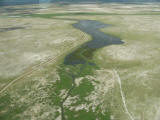
Northern end of the Amboseli swamp from the air
We flew over the elephant research camp, which is hidden in between bushes, such that it is totally invisible from the outside. The only entrance has a big "No Entry" sign.
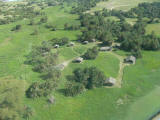
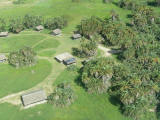
The hidden elephant research camp
On the way to the airfield I saw several groups of elephants.
The landing at Amboseli airfield was gentle and uneventful. One of the team members collected us.
On the way to the research house we drove along the flooded swamp and saw many water birds, including flamingos and this Goliath heron.
At the research house next to Ol Tukai Lodge I saw Echo's skull. Echo, the most well-known wild elephant due to the documentary movie series about her, had died one year ago, in April 2009.
You can see her last set of molars in the lower jaw. They grow on the side of the joint and slowly migrate forward until they finally fall out, while the next set is already moving forward, but elephants get new molars only 6 times in their life. Here you can see what happens when the last pair is worn out. These molars waere already worn down, and the right one was broken or eroded, along with the jaw bone. She was not able to eat well in her last year and suffered not only from an aching tooth, but also from undernutrition. Still she reached an estimated age of 64, which is not bad at all for an elephant.
We went on to the camp, and I moved into my tent.
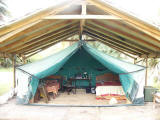
My tent and computer workplace in the bush
After lunch, some rest, and a very nice solar-heated shower, we went out for a game drive and found a congregation of about 250 elephants. You can see so many elephants together only when there is lots of food, like now after the height of the rainy season.
Where in the world can you still see 250 elephants at once? I fear this is the last and only place where this is still happening.
In the morning we drove out to see whether we could find the same elephants again. They had left Amboseli, which they often do overnight, and now we expected them to come in again. In the flat landscape it did not take long to find them.
Elephants' eyes are pointing down their trunks. To look at you, they have to raise their head. In this case, the research car was standing near the elephant.
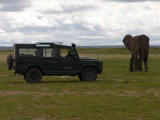
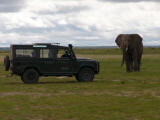
Left: normal stature. Right: looking at the car.
Elephant bulls grow much bigger than elephant cows. An old bull can weigh 7 tons and stand 4 m at the shoulder. They also have much bigger and thicker tusks and bigger heads, which are worn higher.
One of the elephant cows was in estrus, a brief receptive period, lasting only a few days, and was followed by her mate, the biggest bull around and in musth, and a number of other bulls.
Musth is a phenomenon in elephant bulls that can last several months, can be recognized by the musth glands between eye and ear secreting, smelly urine dribbling, and a conspicuous swaying gait with the head being swung from side to side. Musth is often anti-synchronized in the few biggest bulls in one area and has the effects of a several times higher testosterone level, a higher rank, and a much higher chance of mating. Younger bulls are in musth for a much shorter period, if at all, and they can instantly go out of musth when they meet a bigger musth bull or just smell his track. It is usually the biggest musth bull who mates with most of the estrous females in an area, also because the elephant cows strongly prefer to mate with the biggest, most experienced bulls who have already proven their worth by surviving healthily for so long.
In contrast to the bulls, the cows also have musth glands, but these always secrete and apparently convey information about the individual, because elephant cows usually smell each other's musth gland when they meet.
We saw several very young elephant babies as well, which were born into a season of affluent food and should have a very good chance to survive at least a good part of their first year.
After repairing the water pump in the camp we took off for Nairobi in the late morning.
Amboseli airfield is one of the few in Kenya that have a paved runway. Amboseli is an important tourist destination for several reasons:
My next tasks are in Nairobi and have to do with extending my pilot license and renting the aeroplane for our trip. The bureaucratic problems are awkward, and I don't want to bore you with them, so I will skip most of the details and perhaps a few days now.
Today my Internet connection from the Aero Club is much better. It is now routed directly from Kenya to London, then via Amsterdam to Germany. I hope the earlier problems were just a fluke.
In the late afternoon I drove to the former Uchumi supermarket just to the west of Wilson Airport to pull the maximum of KSh 40,000 from a Barclays ATM. The size of the supermarket keeps astonishing me, and there were waiting lines on all ATMs. Kenya is definitely getting richer.
I drove a little further, to the KWS offices at the Langata entrance to Nairobi National Park to ask a few questions about the KWS smartcards. Due to the incredible traffic problems of Nairobi it took me an inordinate time to get to the park entrance, although the distance is only about one kilometer. The people there were helpful and very knowledgeable. I will have to go there again to get at least a second smartcard.
Today I had to take the English Language Proficiency Test. Then I made an appointment on Monday for the medical examination that is required for the extension of my Kenyan pilot license. I will probably not make it in time to the KCAA licensing office that day, so another day, Tuesday, will be wasted. At least it looks as if everything will be ready in time for our group safari.
This morning before sunrise there was a bigger rain shower, and later in the day there were at least two more, the second accompanied by a little thunderstorm. The smell of rain in Africa is even more beautiful than back home.
At 9:00 o'clock I should be flying with a flying instructor for a type checkout on the Cessna 172, the one we will later take along on safari. I found that a Somali Network friend, Bashe, is in Nairobi. He came to the Aero Club, had breakfast with me, and jumped into the plane to make it heavier for some more realism and for his flying experience.
We had already started the engine, when we were told by Wilson Tower that we could not take off, because they had a defective radio system, were using handheld radios, and did not want to handle training flights on top of the normal traffic at the second-busiest airport in Africa. We had to call off the checkout flight and postpone it to another day.
Bashe had to collect some colleagues from the international airport and take them home, and I joined him for a drive across Nairobi. Fortunately the traffic was not quite as bad as on a weekday.
Then we went to his home to meet his family.
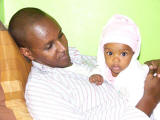

Bashe and his 7-months-old daughter Nila
We chatted into the evening, then he took me back to the Wilson Airport and the Aero Club.
On this Sunday I was invited for lunch to another friend. At the same time I still tried to get the checkout flight, so I had to try to coordinate the activities.
I spent the cloudy and a little rainy morning in the Aero Club on the computer, writing this report and waiting whether the instructor would drop in on his off-day, which he didn't.
So I crossed the town, which was, fortunately, fairly easy on this Sunday, and had a very nice lunch with some friends who work here and travel a lot. Just after lunch one of them set off for a flight to Ethiopia, for example.
Since I had no other obligations, I decided to visit another friend, Asma, who had recently married and moved from London to Nairobi. She is another member of the Somali Network, and after I found her apartment with the help of my GPS, I found that yet another Somali Network member lived just around the corner, a mere 200 m from Asma's place. So we walked over, but I did not know the exact address. We asked at the gates of several gated communities there, but could not find her or her family. She also did not pick up her phone on her old number, and so we have to consider her lost for the time being. I'll make some more attempts to find her again.
Asma walked with me to the big market place near Dagoretti Corner, the place that, besides a huge shopping center, also has a cinema and a wonderful Italian restaurant, and we had some pizza and tree tomato juice. We drank it pure, but it is often mixed with Passion Fruit juice.
We talked about many things, among others about the improving security in Nairobi. I still did not want to walk 1 km at night, because of my extreme vulnerability. (Losing even a minor part of my belongings could ruin my entire vacation and that of my friends too.) So we took a taxi.
When we arrived at the gate, we chatted a bit with the askari (watchman), and Asma asked him whether she could have heard seven gun shots in the evening a few days ago. The askari confirmed that those had been gun shots, and he told us the whole story.
In the area a special interior security force operates, called Flying Squad because of their fast deployment. The askari showed us a little device, smaller than a mobile phone and with just one button, that he wore on a string around his neck and that he can use to call in such help.
That evening three robbers had robbed a nearby Chinese restaurant and escaped by car. Somebody had quickly called in the Flying Squad, which appeared and reached the fleeing car when it got stuck in traffic at the crossroads at Asma's place. Seven shots in quick succession killed the three robbers in their car. Life seems to get tougher for robbers these days.
Today (Monday) we could finally fly. Apparently the tower's radios had been fixed.
Bashe didn't make it on his busy workday, so just the instructor and I took off, and we went through various ways to land on both of Wilson Airport's runways.
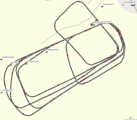
Check flight with one circuit on runway 14
I was considered safe and can now rent and fly the aeroplane on my own.
Directly afterwards I had an appointment with a doctor for a medical examination, which is required annually here for pilots. The doctor found me perfectly healthy, and the examination was quick enough to just barely reach the KCAA licensing office to start the renewal process for my license. I should get it Wednesday afternoon, so I'm still stuck in Nairobi for the second week already. Perhaps I will have a few free days, beginning on Thursday. On the coming Sunday my safari-going friends will already arrive.
This morning I drove over to the KWS office at the entrance of Nairobi National Park, only a few kilometers from Wilson Airport. On the way I stopped at the big supermarket adjacent to Wilson and plundered the ATM again.
At the KWS office I found that they have changed the rules again, which will cause us more problems. They are now bordering on the insane or on repelling tourists. I will describe the new rules in the travel plan.
Then I had a meeting with the owner and his assistant of the small air charter company from which we rent our plane. Their web site has been in limbo or been stolen outright since the former administrator died. I offered to make a new one for them where they can enter information themselves without needing a web designer. In return I get good aeroplane rental conditions. I do not get a lower price, but I do not have high required minimum flying hours per day.
After that I searched for information on some of the airfields we are going to use, particularly Nanyuki Civil. This airfield lies adjacent to the biggest military air base in Kenya and therefore has special rules for entering and exiting the military control zone. I programmed them into my GPS.
I also found the telephone number of the Aberdare Country Club, which is the base station for The Ark, the mountain forest night lodge we will try to visit. As soon as we know that we will reach them in time, we can call them and inquire about available rooms. If there are not enough for us, we can switch to the Outspan Hotel, which is the base station for a similar lodge, Treetops.
Nairobi is still in the grip of the rainy season. I saw low, dark clouds moving by, and while I was writing this in the later evening, I heard the sound of a short, but intense rain shower. But it is still warm.
This morning I again did a lot of preparations. I checked the aeroplane's headset, ordered full tanks for our later departure (which, with luck, we may get without pushing it in person), asked for a rudder trim adjustment, and searched for various pieces and bits of information, mainly on airfields and procedures we will use.
In the late morning, which was cloudy and rainy, I drove to Rasuls' workshop and had the tank lid and its lock fixed, which they could do with just a little bending with the help of a screwdriver. It looked embarrassingly easy.
I also paid them KSh 120,000 in advance, which is the estimated cost of the first of our two cars. This avoids having to pay huge amounts at the end, and it makes us good customers.
I asked them whether this car has a new transmission, but they said no. I guess it must be newer than all I have driven before. Let's see how well the second car will work, which I will get before my guests arrive.
Then I set out to the international airport, specifically to the KCAA licensing office, to collect my renewed pilot license. On the way a rainshower moved across that part of Nairobi. I had the windshield wipers on step 1 for much of the way.
The rainy season has definitely not ended yet, and after the prolonged draught this is a very good thing for most living beings here, particularly the farmers and the savannah animals. For us it is not so good and will make for some interesting driving. We may have to turn back in some places and perhaps use alternative routes, which is always difficult and can take lots of time. But it can also be an interesting adventure.
The office has a lunch break from 13 to 14 o'clock, and I was early, because I wanted to visit Rasuls before they go away for their lunch break at the same time.
I spent most of the time in the KCAA cafeteria and ate a mandazi (sweet dough baked in oil) for a minimal lunch. Then I sat down in the small waiting room and chatted with some commercial pilots who were also waiting. At 14 o'clock the office opened and I got my pilot license without any further problems.
So now, after about 10 days, I'm finally all set up and ready to go. Usually I reserve only one week for this, but the new language test requirement delayed everything. I was right to reserve two weeks for the whole procedure. If they knew what it means for me to take five weeks off for a three-week trip, they would work faster.
In addition to the KSh 3,000 for the test they cashed in another KSh 1,000 to endorse my pilot license, which means that they put it into a typewriter and type: ENGLISH LPR Level 6,expiry Indefinite...)3.5.2010
Not to forget stamp and signature. It looks to me as if they are learning the bad things from the German bureaucracy.
On the way back I was surprised that the streets were already completely dry again with water only visible in some puddles and drainage channels. The relatively dry, thin air along with some sunshine does that.
I arrived back at the Aero Club and filled in the last blanks, particularly a landing permission for the private Naivasha AirSpray landing strip. The telephone connection was very poor, so I sent an SMS and am still waiting for a response.
Now I'm sitting on the Aero Club's terrace at my computer and measure 26°C in the shade while typing and watching the aeroplanes take off and land.
I woke up very early, about 4:30 o'clock, and got going at 4:50. My plan was to drive to Amboseli on the old route to Meshenani Gate where they issue temporary KWS smartcards. I wanted to find out whether we can use Iremito Gate, which does not issue cards, to enter on Monday. I would like to avoid to have to drive over to Meshenani Gate inside the nature reserve to get our cards.
The roads were nearly free at that time of night, and so I quickly left Nairobi on the Mombasa Road. However, the normal road was blocked, and I had to drive halfway to the airport and turn back to be able to continue on Mombasa Road.
Near Athi River I wanted to fill the tank again, so I branched off to the left into a lane that I thought would pass by the petrol station I had already marked in the GPS. However, I landed on a big place where lots of trucks apparently parked overnight. Since the place was totally dark, very difficult to navigate due to ditches and huge holes, and since the headlights of the off-road car only illuminate a small area in front of the car, it was nearly impossible to find my way back out. It took me an inordinate time to get out of there and continue on the main road, trying to find an entrance to the petrol station from the newly built road, but I eventually did. This reconfirmed my rule not to drive at night in Kenya.
The way to Kajiado, Namanga and Amboseli from the Mombasa Road was also difficult to find and drive. There were signs, but when I followed them, I found myself in a situation where I was standing between oncoming traffic, not sure where to go next. But then a truck came from behind and drove into the branch that I had already determined as the most likely candidate.
This was all a huge constuction site, but cars had already found ways to shortcut the diversions, making the whole site even more difficult to navigate. But I ended up on the road to Kajiado, which had recently been rebuilt and was in excellent condition.

Nairobi – Namanga – Amboseli – Emali – Nairobi
I visited friends along the way, beyond Kajiado, and arrived there at 8:10 o'clock. Because of the good road I was in no hurry to leave again and stayed with them until around noon, which included a wonderful breakfast. They have a wonderful house, mostly self-built.
Then I left, only to find that the rest of the road to Namanga on the Tanzanian border was one huge constuction site with most my way being driven beside the road.
In Namanga I bought soft drinks, vegetables, fruits, and juice for the research camp. Then I drove the also rather terrible road from Namanga to Meshenani Gate, one of the entrances to Amboseli. The purpose of this exercise was to later spare my safari participants this road by obtaining and loading the required KWS smartcards at this gate, but then later enter from the Mombasa road via Emali and the Iremito Gate, which cannot issue or load the smartcards, but can charge my prepared smartcards and let us in.
Obtaining and loading the cards was complicated. I now have four different cards and can only hope that I did not miscalculate anything.
After finally passing the gate I drove very slowly past the now water-filled Lake Amboseli, through which I normally drive at high speed when it is dry.
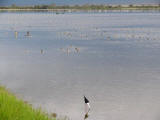
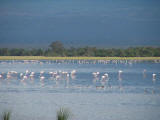
Left: Water birds in Lake Amboseli. Right: Flamingos.
The 5,000 flamingos seemed to be still there. Later I passed by a hyaena clan and watched them for a short while. They were a little too far for any good photos.
Finally I ended up in the camp, took a shower to remove all the dust, had a nice dinner and went to bed in my tent.
Early in the morning, after a mug of Kenyan tea, I joined Graham and Katito for their morning drive. Their aim is to play sound recordings to elephants under controlled conditions to measure and evaluate their response. The results are highly interesting and surprising, but should not be published here and now. Some photos:
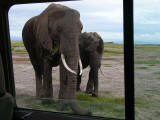
Elephants next to the research car
Elephants are not very shy here, and they know the research cars. So they often walk past the car almost in touching distance, while being totally relaxed.
We saw the famous EB family walking into the nature reserve after not being seen for 6 weeks. This was Echo's family group, is now headed by her niece Eudora and numbers 24 individuals. A splinter group, headed by Echo's sister Ella, counts 8. About 10 members of the group, including Echo herself, have been lost during the prolonged drought before this rainy season.
This morning was very successful for the researchers. They did several tests with the elephants. For me it was highly interesting to observe the research work.
On the way back around noon we stopped at Lake Amboseli again and looked at the water birds.
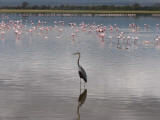
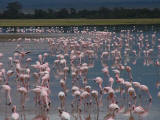
Lake Amboseli, Goliath heron, many flamingos
In the afternoon at least 100 elephants walked all around the camp, some being as close as 20 m from me while I was sitting in front of a tent.
At the moment a whole vervet monkey clan is playing on my tent and on my car. I will have to readjust the mirrors.
This morning I looked out during early dawn, i.e. around 6:10 o'clock, and saw the mountain with only one low cloud collar. I wanted to drive out to take some photos with the magnificent mountain in the background, but shortly after the first rays of the rising sun hit the snow on its peak, a cloud layer formed over Amboseli, obscuring the mountain again.
So I sat at the computer, receiving and answering the last flurry of emails before the safari group gets on the plane and comes to Africa. Later, at around 10, we had a beautiful blue, sunny sky with cumulus clouds distributed densely enough to always obscure the mountain as well.
The mountain never came out again before dark, but the starry sky at night was, as always, incredibly beautiful, particularly because the moon was not there. Nowhere can you see the Milky Way as clearly as in Amboseli, where there is no artificial light far and wide.
I considered driving back to Nairobi very early in the morning, to reduce the risk of not reaching it in time to collect my guests. In the night I heard a dove call. Ah, I thought to myself, the first sign of dawn, got up and switched my mobile phone on to check the time. It was 3:33. So I slipped back into bed to sleep a little longer.
But at around 4:00 a pack of hyaenas started making noise in the grass not far from my tent. My guess is that one had caught some prey and the others found out and tried to get a share. It was pretty noisy.
At 5:50 the birds began to sing in earnest. I got up again, briefly checked email, just in case there was something pertaining to the safari, found nothing urgent, and packed my things.
When I drove out of the camp, Peter, the cook, was already in the kitchen, preparing the early morning tea. We chatted for a moment, but I didn't want to wait for the tea and drove off.
I moved towards the Iremito Gate, when I noticed that the mountain was out and took this photo (unretouched):
I passed the gate, took somebody on who wanted to go to Emali, and we chatted the whole time. He turned out to be well-educated and interesting.
I dropped my hitch-hiker in Emali and continued up the Mombasa Road to Nairobi. As expected, this route turned out to be much easier and somewhat shorter to drive than the Namanga route.
I arrived in Nairobi around noon and so had some time until my guests arrived. I still had to take the second car to the international airport, which I could do with the help of Sajid Rasul.
Then my guests arrived in good shape and with complete luggage. They received a short briefing on how to use the car, and off we went into the African night.
At the airport exit gate we had to show our already paid parking cards, but before we reached the booth, somebody bumped into one of our cars, possibly denting the rear bumper. We looked at the damage, and I guessed that the bumper may have been bent before. We called the Rasuls, and they said, if there is only very minor damage, we should just ignore it and drive off. The driver who had bumped into us was quite happy about this decision.
We continued on to the Aero Club of East Africa. The only difficult junction was eased by road construction that made the joining traffic from the direction of Mombasa very slow, so the entire route was easy to drive.
As we approached Wilson Airport, it began to rain. The intensity of the rain increased as we arrived, so we walked quickly into the club to avoid getting soaked, and left the luggage in the cars for now.
After a welcome drink at the Aero Club's bar we unloaded our luggage, still in moderate rain, protected by some big umbrellas the club makes available for exactly this situation, and eventually went to bed.
For me this was already the third tour to Amboseli this year, but for my guests it was the first time ever.
In the morning we had breakfast from 8 to 9 o'clock to make the transition to the new time zone easier (losing 1 hour).
We made a strong effort to find out the conditions at Mt. Kenya to support the decision of whether to try to climb it. Initially we were not very successful, but later we reached some knowledgeable people and got some information that mostly indicated that this time of the year was not ideal for climbing.
Then we went to the nearby shopping center to get enough drinking water and a few other things like cookies. We also filled the tanks and added a little pressure to two tires that looked a bit low. All this took an inordinate amount of time, and we left Nairobi only around noon, shaving one hour off our intended buffer time. This still left us with about 1.5 hours reserve until sunset, so it did not yet look critical.
We now took the new route via Emali again, which is easy to drive on pretty much perfect roads.

Nairobi – Emali – Amboseli – Emali – Nairobi
We changed drivers a few times, so several of us got their first experience with the cars and should now be able to drive them if the need arises.
As we drove towards Amboseli, the magnificent mountain shed its cloud cap and presented itself in its full glory.
We are having a wonderful time in Amboseli. Ol Tukai Lodge is luxurious and located right in the center of the nature reserve. Some photos:
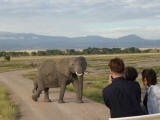
Some of us and an elephant look at each other. Photo: Timm Bauten
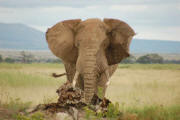
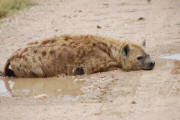
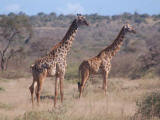
Elephant bull, hyaena, Maasai giraffes. Photos: Jörg Kunze
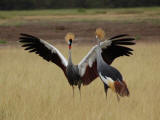
Crested cranes. Photo: Jörg Kunze
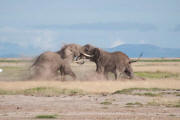
Elephant bulls fighting. Photo: Jan Riedinger

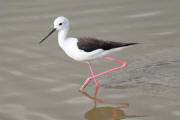

Water birds. Photos: Jan Riedinger
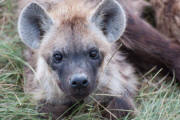
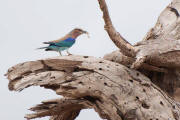
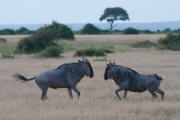
Young hyaena; bird eats maggot; two wildebeest bulls. Photos: Jan Riedinger
We visited the Amboseli Elephant Research Project and met Graeme Shannon, who worked on elephant communications by playing sounds to the elephants and recording, analyzing, and measuring their reaction. The results of his research should be published soon, but I can already say that they are amazing. It seems to me that every time we analyze the abilities of the elephants, they turn out to be more capable than we had thought before.
Graeme gave us a lecture on elephant communications and on his own research. He also demonstrated the sound system built into his research off-road car, a special design capable of emitting loud sounds, particularly bass sounds down to 7 Hz, at realistic volumes, meaning near the pain limit of the human ear.
We learned a lot about elephants, much more than the superficial and often wrong "common knowledge". Thank you, Graeme!
The Kilimanjaro panorama below was stitched from 13 adjacent photos, including the photo shown above in chapter 2010-05-09. In the middle is the main crater, called Kibo. On the left side you can see the secondary peak, Mawenzi, just visible above the clouds.

Mt. Kilimanjaro panorama (created from 13 photos with
Autostitch)
After an early morning game drive, followed by a good breakfast, we set off for Nairobi, hoping that we would have a few hours in the afternoon for the preparation of our next trip.
However, after we had passed Emali and Sultan Hamud, one of our cars began to make rhythmic sounds of increasing intensity, which finally appeared like hits to the chassis of the car.
We analyzed the effects and came to the conclusion that it could only be the failing wheel bearing of the rear left wheel. As the sounds got worse and more intense, we stopped, because we feared that something would break in the next kilometer.
After we had stopped, we looked under the car and found that oil was running down the problem wheel. We called the Rasuls and told them the symptoms and our analysis.
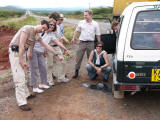
Timm, Mausi, Mark, Gabriele, Jörg, Silvia, Jan
We talked to Sajid Rasul, and he promised us a quick repair. Indeed he came as quickly as he could and brought his car mechanic with him. It turned out that our analysis was exactly right. The bearing had begun to disintegrate.
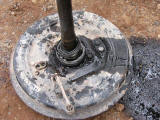

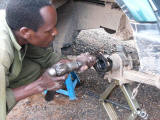
Disintegrating wheel bearing, repair
The mechanic managed to change the entire axle in about half an hour. After that we were on the road, driving a symptom-free car again. This service is beyond what can be had in Germany.
Sajid drove behind us for a while, and when we told him (by mobile phone) that the car was working perfectly, he sped back to Nairobi in his faster car.
Along the way we watched a group of 5 giraffes crossing the Mombasa Road. All cars stopped and watched the giraffes.
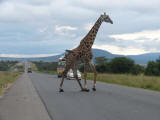
Giraffe crossing the Mombasa Road
Near Nairobi it began to rain. Still on the Mombasa Road, less than 2 km before the turn-off point towards Wilson Airport, we got into a traffic jam that kept getting worse, until the cars were virtually standing still.
Traffic jams in Nairobi are indescribable. You have to experience them to believe. We worked out a method where the second car blocked traffic to allow the first one to change lanes. We also once looked out of the side window, only to peep into a deep hole in the road where a gulley lid had once been, big enough to swallow the wheel of a smaller car whole.
I decided to turn off and try a shortcut that I had once used, but not recorded and not remembered in detail. We reached the parallel road through a petrol station and found that the shortcut indeed works, but only with the help of two very helpful policemen.
We arrived in the Aero Club in continuous rain, had a good dinner, and disappeared into our rooms soon enough.
In the morning, after a good breakfast, the two cars drove out on their own, while three of us remained behind, intending to follow the cars in our Cessna 172 named 5Y-BUU. I always worry a bit when I'm not with the cars, but I learned that they had no problem at all leaving Nairobi on a non-obvious shortcut through the western outskirts. Both cars were equipped with GPS receivers and routes leading the way. I had also pointed out and written down all conceivable mistakes that might be made.
However, the plane could not take off, because the weather was too bad. We delayed the already filed flight plan several times, until we came close to the latest time I would consider to take off, 16 o'clock. Taking off still later would have cut our options short by not including enough daylight reserve.
Around 15 o'clock the weather slowly improved, until we had some sunshine and rising cloud levels, so we decided to give it a try and return to Nairobi if we could not fly past Mt. Longonot. We took off at 16 o'clock and turned northwest.
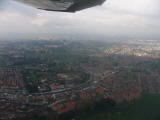
Climbing out from Nairobi. The city is visible in the background. Photo: Silvia
Ackermann
Rising ground and many clouds forced us to turn left a little, so we flew straight towards Mt. Suswa, a big volcano in the middle of the Rift Valley, approximately west-northwest.
There were several openings in the cloud cover, through which we could fly into the Rift valley. We chose the nicest one, still within easy viewing distance of the Ngong Hills, and dove into the Rift Valley there.
Once in the valley, which is about 40 to 50 km wide there, we had no further problems with clouds. They were above us, the peak of Mt. Suswa was in clouds, and the upper half of Mt. Longonot was also in clouds, but both sides were clear and easy to fly at more than 1,000 ft above ground even in the saddle to the East of Mt. Longonot.
We looked at the path leading up the volcano, but could not identify it, much less find our friends or their car, so we continued on to the Naivasha AirSpray airfield, which I had never consciously seen before, not far from Crescent Island, a sunken volcano in the Lake.
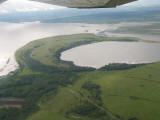
Crescent Island, a sunken volcano in Lake Naivasha. Photo: Silvia Ackermann
It was easy to find and easy to land on. Mausi already expected us, collected us, and shuttled us into the nearby Lake Naivasha Country Club, where we settled into very nice, comfortable rooms.
After a good breakfast we moved towards Lake Nakuru. The cars went on the main road and I intended to wait for about an hour before taking off with the aeroplane and use that hour for some preparation and fuel consumption calculations.
The weather was cloudy, but the clouds were high and the visibility was quite good. However, some dark clouds moved in from the south, which made me change my plans and take off earlier, before it might have begun to rain.
Soon we reached Nakuru and descended towards the large grass airfield at Nakuru Lanet.
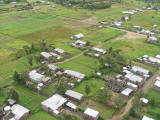
Small farms in Nakuru Lanet. Photo: Silvia Ackermann
We met up again on the Nakuru Lanet airfield and ate our lunch boxes. The lodges provide these when guests depart before lunch time.
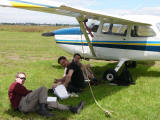
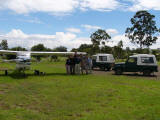
Left: Picnic under the wing. Right: Crew and vehicles.
Before we turned towards the famous Lake Nakuru, we (or rather, our cars) climbed Menengai Crater, the second-largest caldera in the world.
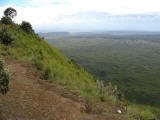
View into Menengai Crater
(This
photo is licensed under the
Creative Commons
Attribution 3.0 Unported license.)
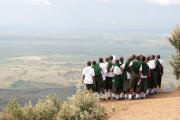
School class looking into the crater. Photo: Jan Riedinger
Then we drove to the eastern, "Lanet", gate of Lake Nakuru National Park and atop the ridge of the eastern hills of the nature reserve to Lake Nakuru Lodge.
Our early morning game drive was unusually successful, because we saw two male lions. The likelihood of seeing lions here on any particular day is low, so we consider ourselves lucky.

Two male lions. Photo: Gabriele Kitzler
Along the way we had a difficult water crossing.

Taking the off-road cars to their limits. Photo: Gabriele Kitzler
We saw many animals and species, including buffalos, various gazelles, waterbucks, zebras, and a whole group of the rare Rothschild giraffe.
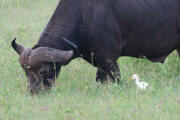
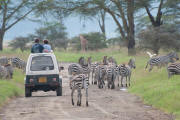
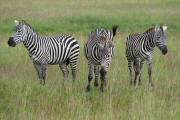
Buffalo and Cattle Egret (German: Kuhreiher); zebras. Photos: Jan Riedinger
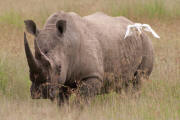
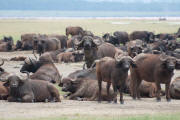

White rhino; buffalos; Little Egret (German: Seidenreiher). Photos: Jan
Riedinger
After lunch we drove out of the nature reserve and into Nakuru town, which feels much more like a typical African city to me than Nairobi. We went to a hotel I had briefly checked a year ago and that we would now test in earnest, the Nuru Palace Hotel.
The hotel turned out to be a good choice with an outstanding performance/price ratio. Its only peculiarity is that it is apparently run by Christian fundamentalists who are opposed to alcohol, so its restaurant offered not even beer or wine. Everything else was fine though, and my observation that the quality of the mosquito nets in hotels is inversely proportional to hotel prices was confirmed once again.
Some of us went to the city center to take a bath in the crowd, and they liked it, apart from some obnoxious people following them around.
We had some rain showers in the afternoon.
In the morning, after a good breakfast, we all drove off to Nakuru Lanet airfield to take the flyers to the aeroplane. After briefly checking that the plane was allright, the two cars left for their drive north to Baringo, while I prepared the plane for its flight.
While I leisurely checked the plane, a grey rain cloud approached us from the south, so we accelerated our takeoff to avoid having to take off in rain or to postpone our takeoff for an undeterminable time.
A few minutes later we were airborne, setting course for a side valley of the Great Rift Valley. Instead of flying straight north to Baringo, we wanted to look at the spectacular western edge of the Kerio Valley, where the ground drops off vertically from the plateau of Eldoret, with several waterfalls and many hillside farms further down.

Nakuru – Kerio Valley – Baringo
After flying along the edge of the Kerio Valley for some time, we eventually turned east and crossed the mountain range, beyond which lay the sweetwater lake of Baringo, which harbors many water birds, hippos, and crocodiles.
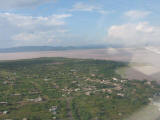
Kampi ya Samaki ("fish camp") on the shore of Lake Baringo. Photo:
Silvia Ackermann
Since we took off early, we now had some time to wait for the cars to collect us from Baringo airfield. We could have walked, but the heat of the relentless sun made us prefer to wait. Baringo was the hottest place we visited.
Eventually the cars arrived, and we moved into the very nice Heron House at Roberts Farm, a private camping and lodging place at the lake shore, where we intended to spend two nights before going on the long drive and flight to Samburu.
Some of us went on an early-morning bird walk and saw not only birds, but also all kinds of other animals, particularly small reptiles and insects.
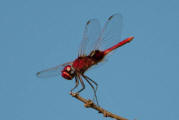
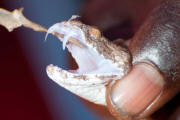
Dragonfly; sand viper. Photos: Jan Riedinger
Later all of us visited the Rehabilitation of Arid Environments project, received a good introductory lecture and visited one of the rehabilitated fields out in the bush. The results of protecting fields from overgrazing by livestock and sowing a carefully selected mixture of suitable grass species are surprising. One would expect better plant growth, but what we saw was far above expectations. It shows that the whole flora in the Baringo area is severely damaged by livestock, particularly goats, but also that it can be rehabilitated by measures involving either effective private ownership of the land, which is formally owned by the community, or by careful planning by the community.

Goats eat nearly everything and do anything for food. Photo: Jan Riedinger
In the afternoon some of us set out for another flight through the Kerio Valley:

From Baringo through the Kerio Valley
Some of us took a boat ride on the lake and watched, among many other animals, fish eagles catching fish from the water surface.
Long drive Baringo – Loruk – Tangulbei – Churo – Mugie – Suguta lol Marmar – Kisima – Lodungokwe – Wamba (bypassed) – Ngotogongoron – Sasaab – Samburu West Gate – Samburu Lodge.
Our aeroplane flew from Baringo to Nanyuki to refuel, then on to Samburu Oryx airfield, while the cars took a more direct, but also long and difficult route.
The flying route could not be flown in a straight line. Instead we had to fly more southerly to gain the altitude to climb out of the Rift Valley over the steep eastern edge. Later we had to fly still more southerly to first fly around the Nanyuki control zone and then enter it from the south, which is the prescribed procedure.
Nanyuki has the biggest military airport in Kenya, and the military does not want private planes to fly over their airport. That is why there are only two access lanes for air traffic to the Nanyuki civil airfield, one on the south side via Naro Moru and one in the northeast past Mt. Kenya Safari Club and Timau.
In Nanyuki Jörg and I decided to take a matatu (private overland minibus) to town, mainly to pull some money from an ATM. Some photos from the main matatu place in Nanyuki:
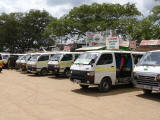
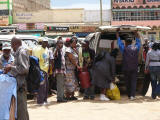
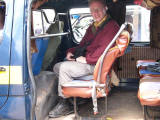
Matatu station in Nanyuki; Jörg has boarded a matatu.
We flew on to the Samburu Oryx (satellite photo) airfield. Meanwhile the cars made their way slowly past Sasaab airfield (satellite photo) towards the West Gate of the Samburu Game Reserve.
For most of their way they had no mobile phone coverage, but they eventually succeeded in sending us a message, indicating that they would be late and just barely make it before sunset. So we walked over to the nearby Samburu Sopa Lodge, sat down on the terrace overlooking the wide river valley and had some drinks from the bar.
Samburu had experienced a devastating flood in early March. All lodges down at the river were severely damaged and had to be rebuilt. Some, like the Samburu Serena Lodge, may be abandoned and never rebuilt.
Since we had little time and were told that our original destination, Samburu Game Lodge down at the river, was not yet operating, we decided that we would have no choice but to stay there. The price was acceptable.
After a few hours the cars arrived and the travellers told stories of hardships, particularly bad roads like the one from Mugie to Kisima, forcing the cars to drive very slowly and sometimes off the track to avoid deep mud holes.
But they were told at the gate that Samburu Game Lodge was, in fact, operating, and so we reversed our earlier decision and decided to drive down to the other lodge, even though we would only make it some time after sunset. Needless to say, the people at Sasaab Lodge were not happy to see the rare customers leave again. At least they had sold us some drinks.
We jumped into the cars and drove down to the river in the setting sun, then downstream, easterly, along the river, past the bridge, to the lodge, where we arrived during the darker part of dusk, not long before it would be totally dark. Our plan B, just in case the lodge would turn out to be closed aftera all, was to drive back to Sopa Lodge in the dark and stay there after all.
When we arrived at the lodge's closed gate, the askari (watchman, guardian) told us that the lodge is closed and not operating. But we insisted to go in and at least talk to one of the people actually running the lodge. The askari gave in and let us pass.
It took us some time to find the lodge manager, and he also told us that the lodge is not yet operating, but it would be in a few days. So we pleaded with him about letting us stay anyway, and he finally told us to wait while he would see what he could do for us. Meanwhile we could have a seat on one of the few already placed easy chairs in the pavilion, one of the architectural specialties of this lodge. The pavilion is a raised, circular room with a thatched roof and a wall all around that is low enough for the guests sitting there to look over it down on the river. It is visible on the aerial photo at the end of the next chapter.
After about one hour, as our patience began to falter, he finally came back and told us that we could stay. Since the kitchen was not fully operative, we would not get the usual five-course dinner, but we would only pay a reduced price, not much more than half the normal price.
We gladly agreed, since our budget was more important to us than luxurious eating, and moved into the rooms, which were already fully up to the normal lodge standards. We also got the best rooms of the entire lodge, spacious, with three beds, more than we needed. This story had a very happy ending.
Samburu and Buffalo Springs are perhaps the most African among the best nature reserves in Kenya. Masai Mara may be the crown jewel among them, but it is so high that the vegetation looks almost European in comparison and doesn't have the palm trees and the kind of dry thorn bush savannah that is typical for the tropics.
The drought before the recent rainy season had taken its toll here too, and the animals were relatively thinly spread. We did see most of the large animal species, even including the rare and shy Greater Kudu, but we did not see any Grevy zebra, a species that used to be typical for Samburu.
One day I wanted to drive across the river into the Buffalo Springs Game Reserve, only to learn that the bridge had also been damaged by the flood so badly that it could not be crossed. In fact, we saw a piece of its guard rail that had been washed to the shore opposite our lodge.
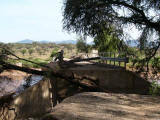
The broken bridge across Samburu River
We made contact with three different zoological research projects that cover the Samburu area. We invited the head of the Ewaso Lions research project, Shivani Bhalla, to the lodge. She gave us a lecture on the life of lions and on her research and answered many questions. She also took us out for a lion search, but even she could not find the lions on that day. We only found some older tracks, and I later heard from her that these lions had relocated further out into the east.
Shivani also drives a Suzuki Maruti Gypsy, so here is her car next to ours:
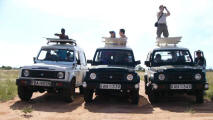
Three Suzuki Maruti Gypsy cars, Shivani's on the left
We also invited May Wykstra, head of a cheetah conservation project and John Dawes, who researches the behavior of the reticulated giraffe and spent some time with them on lectures and question-and-answer sessions.
And of course we did many wonderful game drives.
In the evenings some animals come into the lodge compound. Genet cats are nocturnal. Crocodiles seem to live in a different kind of time and do not care about day or night.
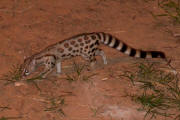
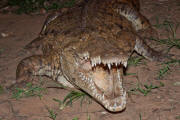
Genet cat; crocodile. Photos: Jan Riedinger
The thatched roofs are a favorite resting place for bats.
One afternoon we made a sightseeing flight to Mt. Kenya and Ol Lolokwe, the table mountain visible from Samburu in the north.

Samburu – Mt. Kenya – Ol Lolokwe – Samburu
The flight to Mt. Kenya was hampered by a strong opposing wind blowing down the slope we were trying to climb. Due to the downdraft component along our entire route we could only climb very slowly and never reached a sufficiently high altitude to get near the peak. On top of that there were clouds around the mountain that obscured at least part of the peak. We eventually gave up and flew back.
We still had just enough daylight time left to fly a bit further in the other direction, towards the north, and fly past Ol Lolokwe, the conspicuous table mountain visible from Samburu, which some of us climbed the next day.
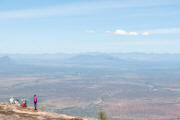
Atop Ol Lolokwe. Photo: Jan Riedinger
Some aerial photographs of Samburu:
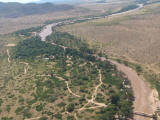
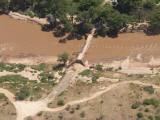
Samburu River and the lodge, invisible under the trees; the destroyed bridge.
Photos: Silvia Ackermann
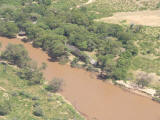
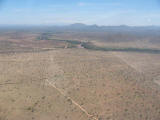
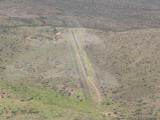
Middle and eastern side of Samburu Lodge;
Landscape with Samburu River;
Samburu South airfield. Photos: Silvia Ackermann
Eventually our time in Samburu came to its end, and we started out to Mweiga. While the cars had to drive to Archers Post because of the broken bridge, then via Isiolo and Timau to Nanyuki, the aeroplane made another attempt at climbing up to the peak of Mt. Kenya.

Samburu – Mt. Kenya – Nanyuki – Mweiga
This time the weather was a bit better. The peak was mostly clear of clouds, and the wind was not quite so bad as it had been the last time. Our weakly-powered Cessna 172 climbed above 12,000 ft, but then the climb rate became so low that it would have taken us a long time to get not much higher.

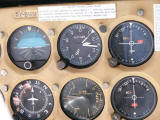
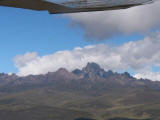
Flight to Mt. Kenya's peak. Photos: Silvia Ackermann
So we throttled the engine and glided back around the north side of the mountain on our way to Nanyuki. We had to follow the procedure to enter the military airport's control zone, but found that on this Sunday the air traffic controller had gone out to lunch. So we did our radio transmissions conscientiously, but blindly, and flew on the prescribed route via Timau and the Mt. Kenya Safari Club to the Nanyuki Civil airfield.
Since Nanyuki Civil is right beside the road and has both airplane fuel and a nice little restaurant, we met up with our driving crew again and had a good lunch before leaving for Mweiga and The Ark.
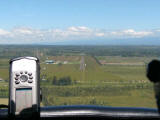
Final approach to Nanyuki Civil airfield. Photo: Silvia Ackermann
The flight to Mweiga was uneventful, but we flew past Mweiga airfield to have a look at The Ark from the air.
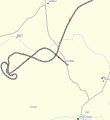
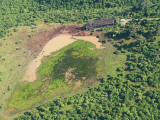
Taking photos of The Ark on the way to Mweiga; The Ark. Photo: Silvia Ackermann
The distance from Nanyuki to Mweiga was not very long, so the cars already arrived at Mweiga airfield when we were landing.
We stayed overnight in The Ark, a forest night lodge located next to a small lake and a salt lick, where forest animals can be observed at night with the help of artificial lighting.

Pied Crow. Photo: Jan Riedinger
Colin, the owner of our aeroplane, was very worried about the takeoff in Mweiga, because somebody had crashed a Cessna 206 there before. He had asked me to do a test takeoff first, without the two passengers.
I did that and experienced no difficulty. The runway is very high, about 6,300 ft above sea level, has a grass surface, is unfavorably sloped, such that in the prevailing southerly wind one has to take off uphill, and the air temperature is quite above that of the standard atmosphere in that altitude, causing the air to be even thinner. On the other hand it is a kilometer long, which is well long enough even for a fully loaded Cessna 172. As you can see in the photo one of my passengers took during the test takeoff, our plane was quite high already while still above the runway. (See also the article Taking a Cessna 172 to high and hot airfields.)
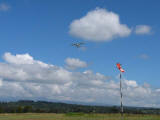
Test takeoff in Mweiga. Photo: Silvia Ackermann
So my passengers boarded the plane, which was now nearly fully loaded. We taxied downhill to the end of the runway and again took off without any problems. As expected, it took the Cessna 172 some 600 m to lift off, but then she climbed nicely into the oncoming wind and cleared the runway and the obstacles behind it easily.
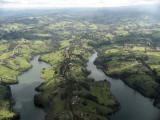
Landscape north of Nairobi in the foothills of the Aberdare mountain range.
Photo: Silvia Ackermann
For this trip we had returned the aeroplane and drove with just the two cars.
We stopped in Narok to get money from the local Barclays ATM, only to find that the machine was manipulated in a way that affects mostly tourists. The feeding mechanism for the bank notes failed when the maximum of KSh 40,000 were requested and kept the money inside the machine.
To somebody from an industrialized country this sounds far-fetched, because there any ATM manipulations come from criminal outsiders. In Kenya they come from the bank employees. It was interesting to hear how all bank employees we talked to insisted that the ATM is working fine and needs no repair, because it fails only when trying to hand out the maximum number of used bank notes.
The machine was, in fact, visibly defective, because even the lid covering the money slot was not closing the slot properly.
We used the ATM three times. The first two times we got no money. The third time I used it and managed to pull out the entire bundle of bank notes by reaching into the slot and forcing them out, with a bank employee watching this and still maintaining that the machine was not defective.
Since I am somewhat used to such scams in Kenya, I did the best I could to force the bank employees to yield the money, by making as much noise as possible and telling at least one of them outright that I suspect a scam. We particularly insisted to get the printed internal ATM log, and the bank manager ended up yielding that. We analyzed it and found that the first transaction would be rejected already by the machine, but the second one showed an error in the machine's internal log, stating that it could not be determined whether the money was taken.
[The person taking the loss had both transactions refunded later, the first one presumably automatically, the second one because of a helpful home bank that rejected and reverted the payment after getting the full information including the ATM log.]
We had lunch at the Kobil petrol station just after the bridge, then continued on to Masai Mara Fig Tree Camp, which we reached not long before sunset after a leisurely drive through the grass savannah of the eastern part of Masai Mara.
We did lots of game drives and saw the wealth of wildlife in this wonderful nature reserve, in spite of the recent rainy season and although many animals had died in the earlier protracted drought.
On the 28th we did a long drive north of Talek River to the river Mara with one car.
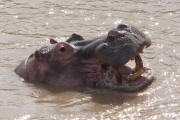
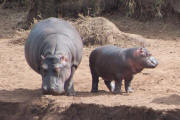
More hippos. Photos: Jan Riedinger
After the rains there were many ticks. The first photo below shows that the wild animals have most to suffer from these nasty parasites.
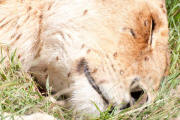
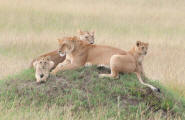
Tick attack; lions in the morning. Photos: Jan Riedinger
On our long game drive we visited Governor's Camp (also called Musiara), which lies directly beside Mara River, and filled our tank there.
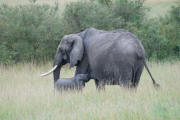

Elephant baby drinking; a bold threat display. Photos: Jan Riedinger
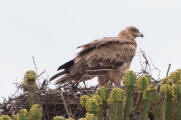

Eagle; bat-eared foxes. Photos: Jan Riedinger
After breakfast we drove back on the same route, again had lunch at the Kobil petrol station in Narok, and resisted the temptation to get more money from the local ATM. We later got some money from a Visa ATM in Mai Mahiu. We could not find any Barclays (MasterCard) ATM there.
In the sunny late Saturday afternoon we arrived in Nairobi and spent quite some time in a traffic jam along Ngong Road even on a weekend, before we reached the Aero Club of East Africa, had a good dinner, and settled down for our last night in Africa.
The next morning we woke up around 4 am and made it to the airport in time. Mausi and I drove the two cars back to Sajid Rasul's home and paid the rest of the car rental fee. Then Sajid drove us back to the airport, where we caught up with the others.
The flight home was uneventful and beautiful. We flew over Lake Nasser, saw the Nile valley, speculated about seeing the pyramids of Giza, which, unfortunately, we didn't, before crossing the Mediterranean towards Greece.
At Amsterdam Schiphol airport our ways parted, and each of us caught his flight back home.
If in this text you find any typos, orthographic errors (even small ones), ungrammatical sentences, wrong or illogical information (like wrong names of birds), if you want me to write more details about something in particular, or if you want one of the photos in full resolution (usually 1,600 x 1,200 pixels), please click on the email sign below and write to me. Many thanks!
Copyright © 2010-2023 Hans-Georg Michna.
Private homepage – Hans-Georg Michna
Kenya travel reports: 1999, 2000, 2002, 2003, 2004, 2005, 2006, 2007, 2008, 2009, 2010, 2011, 2012, 2013-Goma, 2013, 2014, 2015, 2016, 2017, 2018, 2019
Kenya Safari Travel Plan, Flying from high-altitude airfields, Kenya 1980-2000 photos
Jörg's travel report (German) and photos, Mausi's photos
hits since 2010-06-03
Free PHP scripts by PHPJunkYard.com